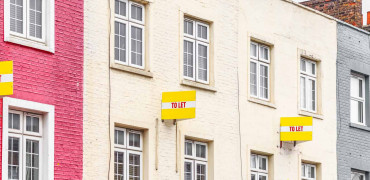Recently the country sizzled in its hottest ever recorded daytime temperature, as the mercury reached 40.3C at Coningsby in Lincolnshire on 19th July, beating the previous record of 38.7C recorded at Cambridge Botanic Garden in 2019.
Heathrow and St James Park in London were close behind with temperatures of 40.2C.
A jump of more than 1.5C was an unprecedented increase from the previous all-time high, but already we have been warned that further rises will happen in the coming years, possibly even in the coming weeks.
Across the nation millions of people spent a very uncomfortable, restless and sweaty night as they were unable to sleep properly in their overly hot homes.
Many of them being exactly the same homes that the residents struggled to keep warm last winter.
The results of the English Housing Survey show how unprepared we really are for spells of hot weather
Health warnings
But the higher temperatures also come with a severe health warning. Tragically some people will have died from dehydration, overheating, heat exhaustion or heatstroke during the recent hot weather.
An additional 2,000 deaths were caused by summer heatwaves in 2020, according to the UK Health Security Agency.
This figure is not as high as the excess deaths from cold weather in winter, but it’s still a threat to many of us and only likely to get worse unless we can modify our homes and infrastructure to better cope with higher temperatures.
Higher death rates start to kick in once the thermometer passes 25C-26C.
The rise in mortality due to hot weather also occurs very sharply, usually within one or two days of temperatures rising. As a result, by the time heatwaves begin, the window of opportunity for effective action is very short, or has already passed.
Even during a relatively cool summer 1 in 5 homes are likely to overheat.
Temperature trends are rising
Britain has been slowly getting warmer since the 19th Century.
In the past three decades, the UK has become 0.9C warmer. Indeed the 10 hottest years since 1884 have all happened since 2002 and none of the coldest years has been recorded this century.
Health professionals and weather experts warned us in advance of what to expect from the raised temperatures, but no amount of advice appeared to prepare us for the record highs.
The rise in temperatures forced the UK Health Security Agency to issue a level 4 heat-health alert - described as an “emergency” and urged the public to take extra precautions to stay hydrated and out of the sun during peak hours.
Across the country grassed areas were swept by fire, roads melted and train tracks buckled in the heat.
In several places houses were destroyed by nearby wildfires that spread to residential properties.
Unsuitable properties
TV news bulletins featured residents of recently built blocks of flats which included large walls of glass panels, providing panoramic views of the outside world, but in the recent heatwave these acted as a magnifying glass to the scorching sunshine, causing huge discomfort to those indoors.
Could these problems have been averted?
Well, yes it seems according to Baroness Brown, deputy chair of the Climate Change Committee. "We've been telling the Government for over 10 years that we are nothing like well enough prepared in the UK for the really hot weather we are seeing now," she said - particularly the extreme heat many people experience in their homes.
In Britain very few homes have air conditioning or external shutters, making the residents more vulnerable during periods of extreme heat.
Both of these features are of course more commonplace around the Mediterranean and in the towns and cities of mainland Europe.
Expert advice
The official advice on what we could do to cool down our homes was pretty limited.
The number one top tip was to provide shade or cover to windows exposed to direct sunlight, with external shutters or shades highlighted as the most effective method, although they are also more expensive and can be difficult to install. Finding a supplier and installer at short notice could also be problematic.
Other suggestions included – drinking plenty of water and other chilled drinks, taking cool showers, moving to a cooler part of the house (especially for sleeping), visiting cooler buildings during the day (such as places of worship, local libraries, shopping malls or supermarkets); and opening windows, when it is safe to do so and when the air feels cooler outside, such as at night.
For our properties and featuring further down the list of experts’ tips, I did also see that in the middle of summer we were still being advised to check that our central heating was turned off (!) and we should be turning off lights and electrical equipment that is not in use.
Of course, well insulated walls and lofts will help keep some of the heat out of a property, while trees and plants near windows can provide shade and also lower temperatures, while using pale, reflective paints on outside surfaces can also help.
Are our homes fit for purpose?
The results of the English Housing Survey show how unprepared we really are for spells of hot weather.
The survey includes questions on how we try to keep our homes cool in the hotter weather. Households were asked which cooling devices they had present in their homes.
Almost all households had an openable window (99%). The next most common device was curtains (83%), followed by blinds (66%), fixed ceiling fans (8%) and then internal shutters (3%).
Right at the bottom of the list we see homes with air conditioners (2%), awnings or canopies that could be unrolled (2%) and fixed shading (1%).
Households who had means of keeping cool aside from just having fixed shading for the windows, were then asked what they do to keep their homes cool.
The most common method of keeping cool was opening the windows (96%), followed by closing the curtains (47%), closing the blinds (42%), switching on an electric fan (32%), closing the shutters (4%), unrolling the canopy (2%) and switching on the air conditioner (2%).
Opening windows
There was no relationship between tenure and opening windows to keep the home cool. However, owner occupiers (2%) were more likely to use an air conditioner to keep their homes cool than both housing association (1%) and local authority (1%) renters.
Households were asked if they could keep cool at night by opening the windows.
Around 47% of households reported always being able to cool down at night by opening a window, 24% said often, 20% said sometimes and just 8% said they could never keep cool by just opening the windows at night.
I expect that figure will rise considerably the next time the survey is conducted.
Owner occupiers (49%) were more likely to report always keeping cool at night in the summer months by just opening a window than both local authority (45%) and private renters (44%).
Households living in urban areas were more likely to report never being able to cool down at night by opening windows (9%) compared with households living in small towns (5%) and villages (5%).
Related to this, households living in London were considerably less likely to always cool down at night by opening a window (36%) than any other region in England.
Adaptations are the answer
So what can we do? Any changes we make to our carbon gas emissions now will not take effect for decades, so the answer appears to be that we will have to adapt our homes.
Installing outside shutters and air conditioning units are the most obvious solutions, while remembering that the latter run on electricity and if the energy is not from a renewable source, then we are adding to the problem!
Investing in improved insulation can help tackle both the extremes of very cold and hot weather, but we need to be wary of sealed windows and walls of glass without ameliorating features being built in.
Hopefully the Government will respond positively to recent events or the vast majority of us will just have to get used to many more uncomfortable days and nights in the future.
Patrick Mooney is editor of Housing Management and Maintenance magazine



